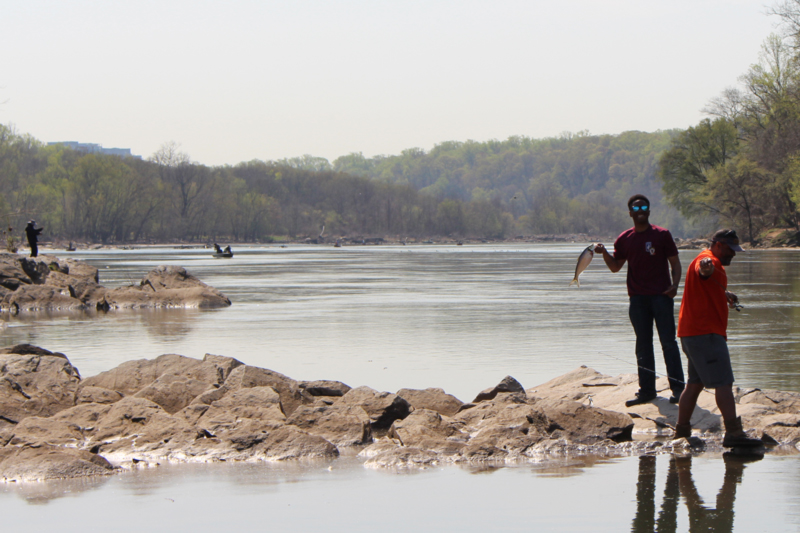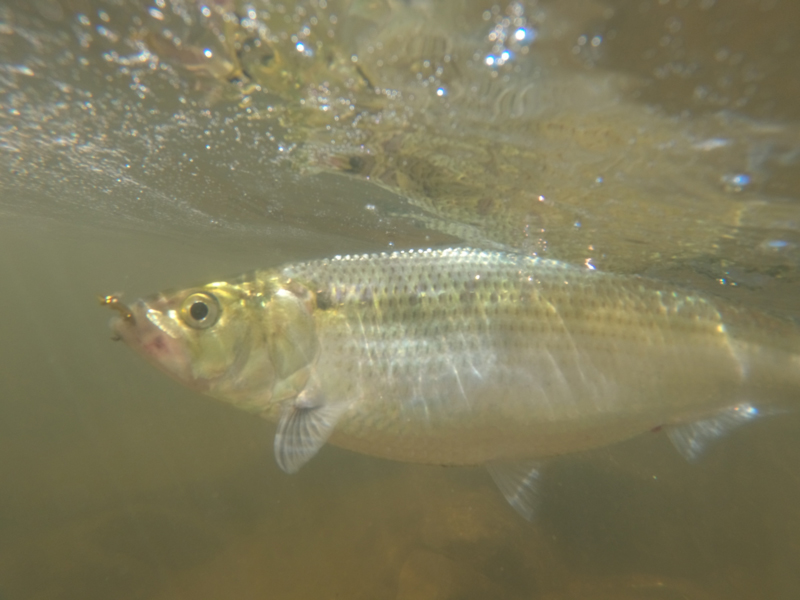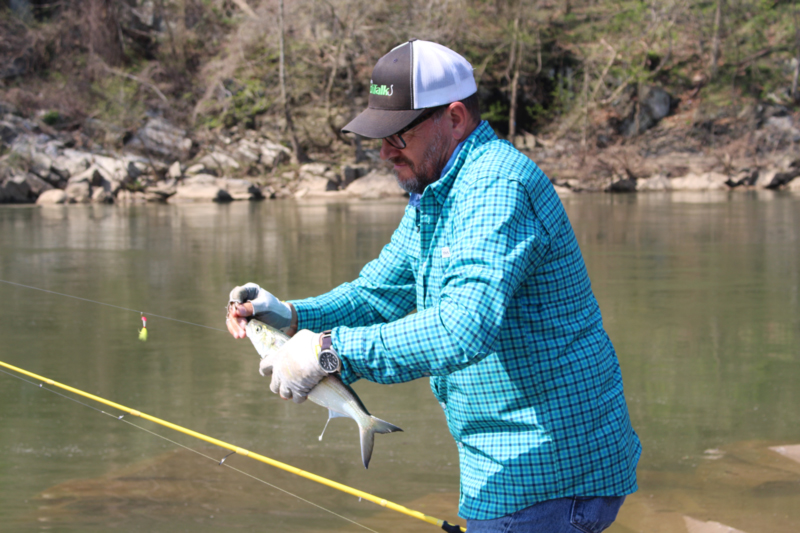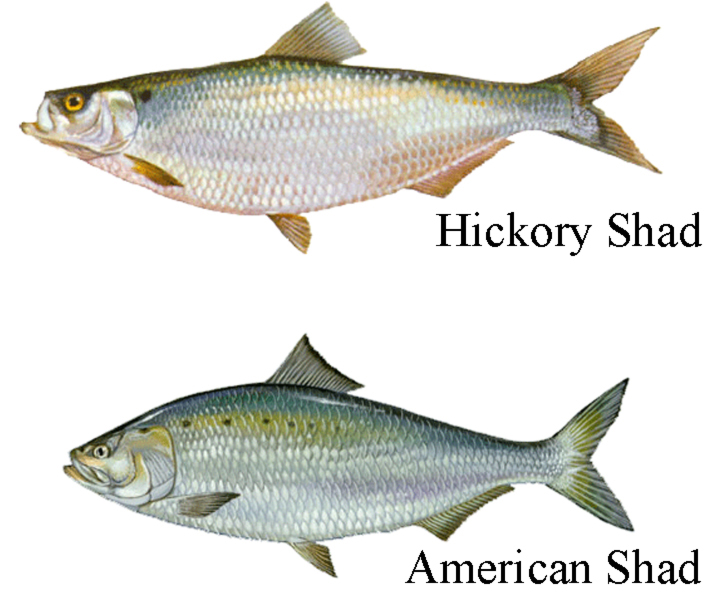Shad are intertwined not only with the rich history of Chesapeake Bay fishing, but also with our nation’s history: they’re often credited with saving the Continental Army from starvation at Valley Forge during the revolution; it’s said to have been George Washington’s favorite fish; and at one time shad were the East Coast’s most important economically important species. This was also one of the first species we humans managed to devastate, by building dams that prevented them from reaching their spawning grounds while also netting them up by the bazillions. Yet even today, the spring shad runs give anglers an early shot at bending a rod in idyllic, if sometimes crowded, settings. Before we dig into the how-to/where-to of shad fishing in detail, check out this How to Catch Shad video:
In many areas shad fishing is a catch-and-release only endeavor, rescuing anglers from the conundrum of choosing between eating a fish known for being riddled with tiny bones yet named sapidissima, meaning “delicious,” for their sweet flavor and delicate taste. In other areas some species can be kept and are popular as much for bait as they are for eating. One thing everyone agrees on, however, is that catching shad is incredibly fun. These fish are hard fighters which dart every which way in a fraction of a second, leap clear of the water, and use the current to their advantage to tug far harder than most fish their size.

Fishing Gear for Shad
Shad fishing can be done from a boat but part of its appeal is that shoreline fishing can be just as productive, if not more so, in many of the upriver areas they’re found during the run. Places like the City Dock on the Rappahannock and Fletcher’s Cove on the Potomac offer anglers the ability to cast from the shoreline and tie into one shad after the next. Hotspots are well within casting distance, but in order to reach the seams in the current and drop-offs where the fish are most often found, most anglers favor relatively long rods in the seven-foot range and reels spooled with light but strong 12- to 15-pound braid mainlines.
Shad will hit small spoons and, naturally, shad darts, but they can get quite picky about just what they’ll strike from day to day. One morning a red/white dart might be the hot ticket, the next a tiny gold spoon gets all the bites, and the day after that silver might be the magic color. To figure out what will work on any given day while presenting multiple options, most shad sharpies cast a tandem rig. They’ll start with two very different darts or spoons, swap them out often until getting some bites, then hone down the offerings to give the fish what they want.
Note that this fish’s picky nature and an angler’s ability to nail down the hot lure of the day is what often accounts for a wide range of success rates between different anglers. When shad fishing, it’s not uncommon for one person to hook up on cast after cast while a fisherman standing 10 feet away flails the water in vain. If you ever find yourself growing frustrated as a nearby angler enjoys far better success, be sure to put a hairy eyeball on what they’re casting and mimic the lure as closely as possible.
Most anglers will use leader in the 10-pound range though some swear that going lighter will increase the number of bites you get, while others prefer to up the ante and use 12- or 15-pound fluorocarbon to reduce break-offs. You can tie a dropper loop or a drop leader two to three feet up the line to dangle your dart, then tie a spoon to the long end of the leader to complete the rig. Fly anglers will often default to a resin spoon or sinking bead-eye flies similar to miniature Clousers or streamers with a number-six or smaller hook.

In all of these cases, the one commonality is to keep your offering small — very small. Even the largest of shad are caught on lures that generally max out at an inch and a half. Naturally, with lures this small even a tandem rig with two offerings sinking at the same time won’t always get deep enough to reach the fish, especially in a current. When this is the case many shad anglers will add a split-shot a few feet up the line to help get it down.
Seams Like a Shad Fishing Winner
When choosing a spot for shad fishing, you’ll often do best where you can spot and cast to a seam in the current between sections of water moving at different speeds. These visible water barriers tend to congregate the fish, and are your best visual indication of where they’ll likely be staging.
With a seam in sight, cast out beyond it, allow the offering to sink for a bit, then retrieve through the seam. Just how long you allow the rig to sink is critical, since the bulk of the fish will usually be congregated at a specific depth. But, that depth changes from day to day and even hour to hour. So make your first retrieve with a short three to five second sink. Then give it a 10-count. Next try a 15-count, and so on, until the rig is reaching bottom before you begin the retrieve. When you get a strike, mimic the count you were using on the next few casts and see if you’ve Identified the depth the fish are holding at.

A slow retrieve with very subtle twitches of the rod tip is normally the most effective for shad. That said, there are times when they’ll want a bit more speed and/or action in the lures. So start out slow and steady, but again, vary your presentation when you’re not getting bites until you can figure out what the fish want.
The moment you feel a shad nip at your lure, bring your rod tip up and set the hook. And when taking the hook out, don’t squeeze the fish too hard or toss it through the air and back into the water — be gentle with the shad. Remember, after all, they were a favorite of the father of our nation.
Shad Fishing Regulations
In the state of Maryland and in Washington D.C., both hickory and American shad are closed to harvest and must be immediately released. In Virginia, American shad are closed to harvest and must be released; hickory shad are open to harvest but are limited to 10 fish in specified waterways. See the Virginia DWR regulations for more detailed information.
American Shad vs. Hickory Shad
Hickory shad generally run a pound or two and arrive up the rivers in late March or early April, then run through about the end of the month. Americans arrive slightly later in the game and can get a lot bigger, sometimes pushing over five pounds. The most definitive way to differentiate between the species is to look at the jaw. With the mouth closed, the lower jaw protrudes well past the upper jaw in the case of hickory shad. On American shad the jaws are of about equal length.

Okay: are you ready to head out and catch some shad? We certainly hope so, because fishing for shad is every bit as American as baseball and apple pie. Just ask George Washington.